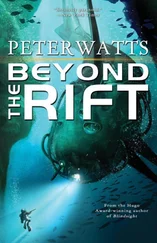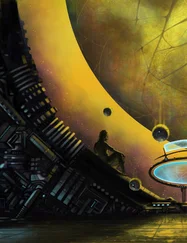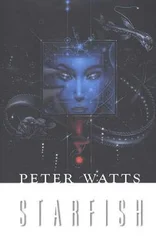You can't blame any of these good folks if this book sucks, since none of them were allowed to read it. (If it does suck, maybe that's why.) You can't even blame David Hartwell, who did read it, because the book would have sucked even harder without his input. You can only blame me, and you might as well since I've already got your money.
Well, fifty cents of it, anyway.
Once again it's time to trot out a variety of citations that will hopefully serve as a valuable educational resource, even though they're primarily intended to cover my ass against nitpickers.
If you have come late to this saga, you may not find the following references as complete as you'd like. Any real-world science elements introduced in Starfish and Maelstrom were cited at the end of those books; I don't repeat those citations here, even though many elements persist into ßehemoth . (I do, however, cite related research that has come out since Maelstrom was released, especially if it makes me look especially prescient in some way.) So if you're looking for my original sources on smart gels, «fine-tuning», or the Maelstrom Ecosystems, you'll have to go back and check the other books. You still may not find everything you're looking for, but you might at least make my Amazon numbers look a little less dismal.
Atlantis: There Goes the Neighborhood
There is a place in the middle of the North Atlantic where the currents stop dead, an eye in the middle of that great slow gyre revolving between Europe and North America [1] Van Dover, C.L., et al. 2002. Evolution and biogeography of deep-sea vent and seep invertebrates. Science 295: 1253–1257.
. It seemed like a reasonable spot to hide from lethal particles potentially borne on wind and water, so I put Atlantis there. The surrounding topography took some inspiration from a 2003 report on abyssal mineralogy [2] Rona, P.A. 2003. Resources of the sea floor. Science 299: 673–674.
. Impossible Lake was inspired by the ultrasaline lens of heavy water described in the ground-breaking documentary series "Blue Planet" [3] British Broadcasting Corporation. 2001. The blue planet: a natural history of the ocean, Part 3: The Deep.
. The failure of the Labrador Current and the Gulf Stream is increasingly likely in view of increased melt water discharge from the Arctic ( e.g ., [4 4 Peterson, B.J., et al. 2002. Increasing river discharge to the Arctic Ocean. Science 298: 2171–2173.
, 5] 5 Weaver, A.J., and C. Hillaire-Marcel. 2004. Global warming and the next ice age. Science 304: 400–402.
). And I know they don't actually figure into the plot anywhere, but Lenie Clarke worries about them on her way to the surface in Chapter One so it's fair game: giant squids now outmass the whole human race , and they're getting even bigger [6] Bildstein, T. 2002. Global warming is good (if you like calamari). Australasian Science , August 2002.
!
ßehemoth
We continue to discover life increasingly deep in the lithosphere. At last count, deep crustal rocks beneath the Juan de Fuca Ridge—yes, the very ridge from which ßehemoth escaped at the end of Starfish —have yielded evidence of heretofore unknown microbial lifeforms [7] Cowen , J.P, et al. 2003. Fluids from Aging Ocean Crust That Support Microbial Life. Science 299: 120–123.
. Water samples from boreholes 300 m below that seabed show depleted levels of sulphate: something down there is alive, unclassified, and consuming sulphur. There's no evidence that it would destroy the world if it ever reached the surface, but then again there's no evidence it wouldn't , either. I can always hope.
That hope is a faint one, though. Patricia Rowan was right to argue that ßehemoth, by virtue of its ancient origins, should be an obligate anaerobe [8] Kasting, J.F., and J.L. Siefert. 2002. Life and the evolution of Earth's atmosphere. Science 296: 1066–1068.
. To even make it out onto the seabed would require either a very convenient mutation, or a deliberate tweak. Damn lucky the plot called for one anyway.
Waters et al. have recently reported the discovery of an ancient, hot-vent-dwelling nanobe called Nanoarchaeum equitans [9] Waters, E., et al. 2003. The genome of Nanoarchaeum equitans: Insights into early archaeal evolution and derived parasitism. Proc. Nat. Acad. Sci. 100: 12984-12988;
; genome size, proportion of junk DNA, and diameter are all in the ßehemoth ballpark. Even better, it's a parasite/symbiont (it lives on a much larger Archeon called Ignicoccus ). However, its minimalist genome (about 500 kilobases, half the size of ßehemoth's) lacks the recipes for certain vital enzymes, which it must therefore get from its host. It could never be a free-liver. ßehemoth, with its larger genome, is more self-sufficient—but how it crams all those extra genes into a capsule only 60 % the size remains a mystery.
The fishheads and the corpses got into a bit of a debate about the odds of ßehemoth hitching a ride in the flesh of dispersing larval fish. I was always worried about that myself, even back when I was writing Starfish —if true, there'd be no reason why ßehemoth would not have, in fact, taken over the world billions of years ago. Invertebrate larvae do seem to cross vast distances in the deep sea; fortunately they generally go into a sort of arrested development en route1, making them unlikely carriers of ßehemoth (which needs an actively-metabolizing host to withstand long-term thermo-osmotic stress). It also appears that even highly-dispersing larval fish species maintain fairly distinct geographic ranges, judging by the lack of genetic flow between populations around adjacent islands [10 10 Palumbi, S.R., and R.R. Warner. 2003. Why Gobies are like Hobbits. Science 2003 January 3; 299: 51–52.
, 11] 11 Taylor, M.S., and M.E. Hellberg. 2003. Genetic Evidence for Local Retention of Pelagic Larvae in a Caribbean Reef Fish. Science 2003 January 3; 299: 107–109.
. Worst comes to worst, local topographic and chemical conditions can constrain the distribution of various deep-water species [12 12 Vrijenhoek, R.C. 1997. Gene flow and genetic diversity in naturally fragmented metapopulations of deep-sea hydrothermal vent animals. J. Heredity. 88: 285–293.
, 13] 13 Somero, G.N. 1992. Biochemical ecology of deep-sea animals. Experientia 48, 537–543.
.
So I dodged the bullet. This was not prescience on my part, and it may yet come back and bite me in the ass: at least one adult fish may have swum through deep water from Patagonia all the way up to Greenland [14] Møller, P.R., et al. 2003. Fish migration: Patagonian toothfish found off Greenland. Nature 421, 599.
.
Seppuku
Artificial microbes are almost mainstream these days: J. Craig Venter (the Human Genome guy) has completed an entirely artificial genome even as I type [15] Zimmer, C. 2003. Tinker, tailor: can Venter stitch together a genome from scratch? Science 299: 1006–1007.
, hoping that such organisms will be able to cure the world's environmental ills. Peter Schulz and his team have already tweaked E. coli to synthesize a novel amino acid not found in nature [16] Mehl, R.A., et al. 2003. Generation of a Bacterium with a 21 Amino Acid Genetic Code. J. Amer. Chem. Soc. 125:935–939.
, hoping it will be able to outcompete the baseline strain. Entirely synthetic organisms, built from interchangeable genetic modules, are just around the corner [17] Ferber, D. 2004. Microbes made to order. Science 303: 158–161.
. I wish all these guys better luck than Jakob Holtzbrink's gel-jocks had when they tweaked ßehemoth.
Читать дальше









